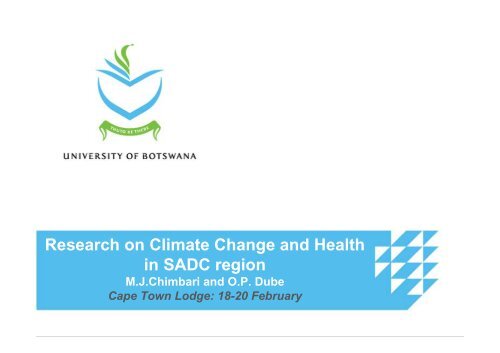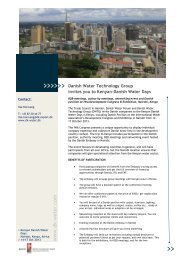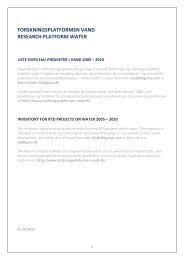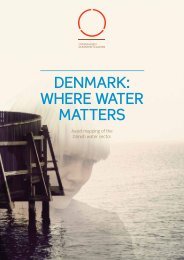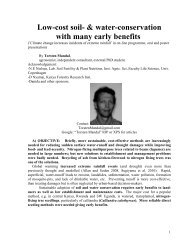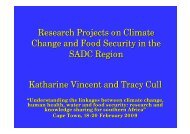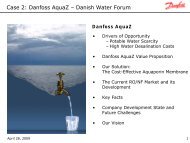Research on Climate Change and Health in SADC region - DDRN
Research on Climate Change and Health in SADC region - DDRN
Research on Climate Change and Health in SADC region - DDRN
Create successful ePaper yourself
Turn your PDF publications into a flip-book with our unique Google optimized e-Paper software.
<str<strong>on</strong>g>Research</str<strong>on</strong>g> <strong>on</strong> <strong>Climate</strong> <strong>Change</strong> <strong>and</strong> <strong>Health</strong><strong>in</strong> <strong>SADC</strong> regi<strong>on</strong>M.J.Chimbari <strong>and</strong> O.P. DubeCape Town Lodge: 18-20 February
Background• CC phenomen<strong>on</strong> is now better understood than <strong>in</strong> 1988when Intergovernmental Panel <strong>on</strong> <strong>Climate</strong> <strong>Change</strong>(IPCC) was formed• First report of IPCC formed basis for establishment ofUnited Nati<strong>on</strong>s Framework C<strong>on</strong>venti<strong>on</strong> <strong>on</strong> <strong>Climate</strong><strong>Change</strong> (UNFCCC)• UNFCCC currently has 189 members• At its 28 th Sessi<strong>on</strong>, the UNFCCCC Subsidiary Body forScientific <strong>and</strong> Technological Advice (SBSTA) recognizedthe role of CC regi<strong>on</strong>al centres <strong>and</strong> networks <strong>in</strong>enhanc<strong>in</strong>g adaptati<strong>on</strong> ; <strong>and</strong> encouraged theestablishment of new networks• Global <strong>and</strong> Regi<strong>on</strong>al Networks for <strong>Climate</strong> <strong>Change</strong>Adaptati<strong>on</strong> are c<strong>on</strong>currently be<strong>in</strong>g established (UNEP)
Background• Third <strong>and</strong> forth IPCC assessments highlighted that Sub-Saharan Africa (SSA) will be affected most because ofvarious reas<strong>on</strong>s <strong>in</strong>clud<strong>in</strong>g poverty, weak health<strong>in</strong>stituti<strong>on</strong>s, c<strong>on</strong>flicts, etc• But <strong>in</strong>ferences <strong>on</strong> Africa are based <strong>on</strong> scanty data <strong>and</strong>shar<strong>in</strong>g of such <strong>in</strong>formati<strong>on</strong> has not happened <strong>in</strong> asystematic manner• It is aga<strong>in</strong>st this background that the Danish <strong>in</strong>stituti<strong>on</strong>s<strong>and</strong> some southern africa <strong>in</strong>stituti<strong>on</strong>s <strong>in</strong>itiated this workas a basis for establish<strong>in</strong>g a NSS network <strong>on</strong> CC• Background papers focuss<strong>in</strong>g <strong>on</strong> the impacts of CC <strong>on</strong>three themes: health, water <strong>and</strong> food security were thuscommissi<strong>on</strong>ed.
Focus of work carried out• Assessment of status of human health <strong>in</strong> Africa <strong>and</strong><strong>SADC</strong> <strong>in</strong> particular, <strong>in</strong> the c<strong>on</strong>text of CC• Highlight<strong>in</strong>g knowledge <strong>on</strong> l<strong>in</strong>kages of CC <strong>and</strong> <strong>Health</strong>• Mapp<strong>in</strong>g of <strong>in</strong>stituti<strong>on</strong>s work<strong>in</strong>g <strong>on</strong> CC <strong>and</strong> <strong>Health</strong> with<strong>in</strong><strong>SADC</strong>• Assess<strong>in</strong>g the extent to which work <strong>on</strong> CC is be<strong>in</strong>g d<strong>on</strong>e<strong>in</strong> comparis<strong>on</strong> to other sectors like water <strong>and</strong> agriculture• Identify<strong>in</strong>g knowledge gaps opportunities for scientists<strong>and</strong> policy makers to work together
Burden of diseases <strong>in</strong> DALYS for theAfrican Regi<strong>on</strong>DiseaseMortality stratumHigh child, high adult (000)AIDS 14 620 49 343Malaria 20 070 20 785High child, very high adult(000)Respiratory <strong>in</strong>fecti<strong>on</strong>s 18 976 16 619Per<strong>in</strong>atal c<strong>on</strong>diti<strong>on</strong>s 10 869 10485Diarroea 11 548 11 689
Ne<strong>on</strong>atal mortality rates (per 100000) for WHO regi<strong>on</strong>sSource: Adopted from World <strong>Health</strong> Report of 2008
How climate change may impact <strong>on</strong>health(IPCC FAR, 2008)
Investment <strong>in</strong> health as a driver ofec<strong>on</strong>omic growth (Adopted from Saunders et al)Where is the 15% GDPFor <strong>in</strong>vestment <strong>in</strong><strong>Health</strong>?Investment<strong>in</strong> healthImprovedhealthstatusEnhancedlabourproductivityImprovededucati<strong>on</strong>alatta<strong>in</strong>mentIncreasedsav<strong>in</strong>gs &<strong>in</strong>vestmentImprovedec<strong>on</strong>omicgrowthLowerdependencerati<strong>on</strong>
Demographic <strong>in</strong>dicators for 2004 <strong>in</strong> <strong>SADC</strong>YearLifeexpectancyat birthAdultliteracyHDI Under fiveCMR/1000IMR/1000Mauritius 72.4 84.4 0.80 15 14 22South Africa 47.0 82.4 0.65 67 54 150Swazil<strong>and</strong> 31.3 79.6 0.50 156 108 230Namibia 47.2 85.0 0.63 63 47 270Botswana 34.9 81.2 0.57 116 84 330Lesotho 35.2 82.2 0.49 82 61 n.a.Zimbabwe 36.6 n.a. 0.49 129 79 700Kenya 47.5 73.6 0.49 120 79 410DRC 43.5 67.2 0.39 205 129 1300Madagascar 55.6 70.7 0.51 123 76 470Zambia 37.7 68.0 0.41 182 102 730Tanzania 45.9 69.4 0.43 126 78 580Ug<strong>and</strong>a 46.4 66.8 0.44 138 80 510Malawi 39.8 64.1 0.39 175 110 1100Angola 41.0 67.4 0.44 260 154 n.aMozambique 41.6 n.a 0.39 152 104 410MMR/100000
Current <strong>and</strong> possible future impacts <strong>and</strong> vulnerabilities associated withclimate variability <strong>and</strong> climate change <strong>in</strong> Africa (IPCC FAR, 2008)
Examples of current ‘hotspots’ or risk areas forAfrica (IPCC FAR, 2008)
Examples of current ‘hotspots’ or risk areas for Africa(IPCC FAR, 2008)
Multiple problems for African regi<strong>on</strong>
Extreme 1980s events <strong>in</strong> different regi<strong>on</strong>s show<strong>in</strong>g numbers 1990saffected (WHO, 2000)EventsKilledAffectedEventsKilledAffected(thous<strong>and</strong>s) (milli<strong>on</strong>s)(thous<strong>and</strong>s) (milli<strong>on</strong>s)Africa 243 417 1 37.8 247 10 104.3EasternEuropeEasternMediterranean66 2 0.1 150 5 12.494 162 17.8 139 14 36.1Lat<strong>in</strong> America<strong>and</strong> CaribbeanSouth EastAsiaWesternPacific265 12 54.1 298 59 30.7342 54 850.5 286 458 427.4375 36 273.1 381 48 1 199.8Developed 563 10 2.8 577 6 40.8Total 1 848 692 1 336 2 078 601 1 851
Vector borne diseases likely to be impacted<strong>on</strong> by climate change (WHO, 1997)DiseaseLikelihood Vector Present distributi<strong>on</strong> People atof changerisk(milli<strong>on</strong>s)Malaria +++ Mosquito Tropics/subtropics 2020Schistosomiasis ++ Water snail Tropics/subtropics 600Leishmaniasis ++ Phlebotom<strong>in</strong>e Asia/souththern 350s<strong>and</strong>fly Europe/Africa/AcericasChagas diseas + Triatom<strong>in</strong>e Central <strong>and</strong> South 100bug AmericaSleep<strong>in</strong>g sickness + Tstetse fly Tropical Africa 55Lymphatic + Mosquito Tropics/subtropics 1100filariasisDengue ++ Mosquito All tropical countries 2500-30000Onchocerciasis + Blackfly Africa/Lat<strong>in</strong> America 120Yellow fever + Mosquito Tropical South -Dracunculiasis(Gu<strong>in</strong>ea worm)? Crustacean(copepod)America <strong>and</strong> AfricaSouth Asia/Arabianpen<strong>in</strong>sula/Central-WestAfrica+++=most likely, ++=likely, +=less likely, ?=uncerta<strong>in</strong>100
Mapp<strong>in</strong>g TemplateCountry Instituti<strong>on</strong>s Theme ofactivitiesDescripti<strong>on</strong>of activitiesFund<strong>in</strong>garrangementsImplementati<strong>on</strong>c<strong>on</strong>text:Programme,network, <strong>in</strong>
Number of references quoted <strong>in</strong> theIPCC FAR Africa chapterTheme<strong>Climate</strong> change<strong>and</strong> <strong>Health</strong>outside <strong>SADC</strong><strong>Climate</strong> change<strong>and</strong> health <strong>in</strong><strong>SADC</strong><strong>Climate</strong> changegeneralNumber ofprojects11 (9.1 9.06 5.0104 86.0Total 121 100% number ofprojects
Number of <strong>in</strong>stituti<strong>on</strong>s where CC work relatedto health is c<strong>on</strong>ducted <strong>in</strong> <strong>SADC</strong>
Number of <strong>in</strong>stituti<strong>on</strong>s per country where CC workrelated to health is carried out <strong>in</strong> <strong>SADC</strong>
Projects identified by <strong>SADC</strong> LDCs <strong>in</strong> theirNAPAs
Prioritizati<strong>on</strong> of health issues <strong>in</strong> LDCsNAPAsCountry Number of projects <strong>Health</strong> Prioritizati<strong>on</strong>DRC 3 0Lesotho 8 0Malawi 5 0Mozambique 4 0Madagascar 15 13, 14Tanzania 6 6Zambia 9 9
Networks <strong>in</strong> the SSA• Capacity Strengthen<strong>in</strong>g of Least Developed Countries<strong>on</strong> <strong>Climate</strong> <strong>Change</strong> Adaptati<strong>on</strong> (CLACC)http://www.clacc.net1. Africa Center for <strong>Climate</strong> <strong>and</strong> Earth System Sciences(ACCESS) www.africaclimatescience.org2. ACCCA project www.accaproject.org3. Air Polluti<strong>on</strong> Informati<strong>on</strong> Network for Africa (APINA)http://www.se/<strong>in</strong>dex.php?secti<strong>on</strong>=atmospheric&page=projdesc&projdescpage=99924. Regi<strong>on</strong>al Air Polluti<strong>on</strong> In Develop<strong>in</strong>g Countries(RAPIDC) http://www.sei.se/rapidc5. Nati<strong>on</strong>al Envir<strong>on</strong>mental Management Council (NEMC)http://www.nemctan.org
Networks <strong>in</strong> the SSA• Southern African Nordic Centre http://www.sanord.org• Africa Center for <strong>Climate</strong> Earth System Science(ACCESS) www.africaclimatescience.org• Air Polluti<strong>on</strong> Informati<strong>on</strong> Network for Africa (APINA)http://www.sei.se/<strong>in</strong>dex.php?secti<strong>on</strong>=atmospheric&page=projdesc&projdescpage=9992• Regi<strong>on</strong>al Air Polluti<strong>on</strong> In Develop<strong>in</strong>g Countries(RAPIDC) http://www.sei.se/rapidc• <strong>Climate</strong> Systems Analysis Grouphttp://data.csag.uct.ca.za• Nati<strong>on</strong>al Envir<strong>on</strong>mental Management Council (NEMC)http://www.nemctan.org• Southern African Nordic Centre http://www.sanord.org
Networks <strong>in</strong> the SSA• African <strong>Climate</strong> <strong>Change</strong> Fellowship Programme(ACCFP)• African Technology Policy Studies Network (ATPS)• Global <strong>Climate</strong> <strong>Change</strong> Adaptati<strong>on</strong> Network <strong>in</strong> Africa (<strong>in</strong>the process of be<strong>in</strong>g established)• Earth System Science Partnership-l<strong>in</strong>ked networks• Assessment of Impacts <strong>and</strong> Adaptati<strong>on</strong> to <strong>Climate</strong><strong>Change</strong>• Nati<strong>on</strong>al Global <strong>Change</strong> Committees• Pan African Start Secretariat (PASS)• Pages-Africa Network• African Pollen Database (APD) Network
Networks <strong>in</strong> the SSA• Miombo Network• Kalahari Transect• Southern African Fire Network• East African Lakes (IDEAL)• AfriBas<strong>in</strong>s <strong>and</strong> AfriCAT)• Afriflux• IGAC/DEBITS-AFRICA (IDAF)• Clobal Envir<strong>on</strong>mental <strong>Change</strong> <strong>and</strong> Food Security(GECAFS)• <strong>Climate</strong> Variability <strong>and</strong> Predictability (CLIVAR)• Global Energy <strong>and</strong> water Cycle Experiment (GEWEX)• L<strong>and</strong> Use <strong>and</strong> L<strong>and</strong> Cover <strong>Change</strong> (LUCC)
Networks <strong>in</strong> the SSA• Other Human Dimensi<strong>on</strong>s of Global <strong>Change</strong> <str<strong>on</strong>g>Research</str<strong>on</strong>g>• The C<strong>on</strong>sultative Group <strong>on</strong> Internati<strong>on</strong>al Agricultural<str<strong>on</strong>g>Research</str<strong>on</strong>g> (CGIAR)• CLIMAG (<strong>Climate</strong> <strong>and</strong> Agriculture <strong>in</strong> West Africa)
Observati<strong>on</strong>s• Not much work <strong>on</strong> CC <strong>and</strong> health is tak<strong>in</strong>g place <strong>in</strong> SSA. Butglobally <strong>and</strong> <strong>in</strong> East Africa much more work is be<strong>in</strong>g d<strong>on</strong>e• SSA is perceived to be overly vulnerable to CC impacts ma<strong>in</strong>ly<strong>in</strong> the agricultural <strong>and</strong> water sectors that directly or/<strong>and</strong><strong>in</strong>directly impact <strong>on</strong> health• CC effects <strong>on</strong> health will be more significant <strong>in</strong> SSA than isappreciated now• Much of the work <strong>on</strong> CC <strong>and</strong> health is <strong>in</strong> the area of malaria<strong>and</strong> HIV/AIDS• There are many networks (36 identified) <strong>on</strong> CC but databases <strong>on</strong> what they do is not readily available• Mapp<strong>in</strong>g exercise is menti<strong>on</strong>ed by many networks as a priority– ATPS, ZERO <strong>and</strong> CARE Zimbabwe, UNEP-GNCCA,CCAA,CLACC
<str<strong>on</strong>g>Research</str<strong>on</strong>g> Challenges <strong>in</strong> the field ofCC <strong>and</strong> <strong>Health</strong>• Establish<strong>in</strong>g <strong>and</strong> document<strong>in</strong>g l<strong>in</strong>kages between climatechange <strong>and</strong> health• Development or improvement of rapid diagnostic tests• Development of vacc<strong>in</strong>es• Improvement of disease surveillance at state <strong>and</strong> locallevel• Transmissi<strong>on</strong> dynamics studies
Way forward• Collaborati<strong>on</strong> between networks is key forcomplementarity. Jo<strong>in</strong>t efforts with networks that havealready made good progress is encouraged• Awareness campaigns <strong>and</strong> lobby<strong>in</strong>g are necessary toencourage work <strong>on</strong> CC <strong>and</strong> health• More studies <strong>on</strong> health particularly for other diseasesbesides malaria are needed to c<strong>on</strong>v<strong>in</strong>ce policy makers• Fellowships <strong>in</strong>itiatives should be used as knowledgesources <strong>on</strong> CC issues– <strong>Climate</strong> <strong>Change</strong> Fellowship Programme (ACCFP)– Capacity Strengthen<strong>in</strong>g of Least Developed Countries <strong>on</strong><strong>Climate</strong> <strong>Change</strong> Adaptati<strong>on</strong> (CLACC)
Acknowledgement• Danish Instituti<strong>on</strong>s– Danish Development <str<strong>on</strong>g>Research</str<strong>on</strong>g> Network (<strong>DDRN</strong>)– Danish Water Forum (DWF)– Danish <str<strong>on</strong>g>Research</str<strong>on</strong>g> Network for Internati<strong>on</strong>al <strong>Health</strong> (ENRECA)• <strong>SADC</strong> <strong>in</strong>stituti<strong>on</strong>s– Harry Oppenheimer Okavango <str<strong>on</strong>g>Research</str<strong>on</strong>g> Centre (HOORC)– Kalahari C<strong>on</strong>servati<strong>on</strong> Society (KCS)– Global Water Partnership, South Africa (GWP-SA)– Council for Scientific <strong>and</strong> Industrial <str<strong>on</strong>g>Research</str<strong>on</strong>g> (CSIR)– M<strong>in</strong>istry of Energy <strong>and</strong> Water, Zambia• GWP-SA• Peter Furu


